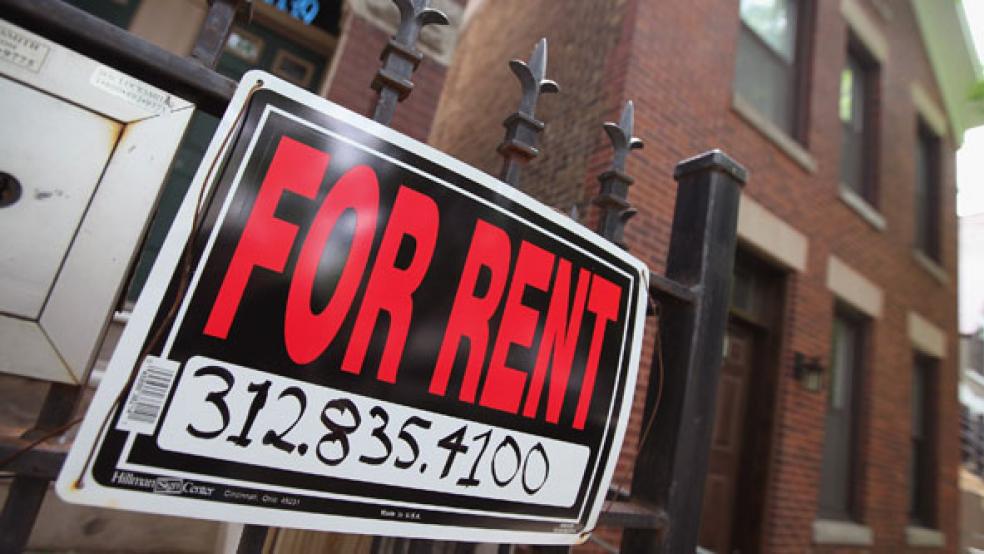Within the dark and battered housing market there is one emerging bright spot: rentals.
In September, builders blew away analysts’ forecasts and began work on 51.3 percent more new multi-family rental units than the previous month. New buildings with two or more apartments surged to 223,000 annually, according to the Census Bureau. While it’s only one month and still well below pre-recession levels of 350,000 units per month, the surprise increase represents a larger upward trend that many experts say will continue to provide work for ailing construction companies and help resuscitate a market that has been lifeless in the two years since the recession ended in June 2009.
“This isn’t the next boom, it’s already booming,” says Mark Humphreys, CEO of Dallas-based Humphreys and Partners Architects, which designs 12 to 13 percent of the multi-family buildings constructed in the U.S. Since the beginning of January, he says his firm’s workload has increased 100 percent. Humphreys and Partners has hired 35 new employees in the last eight months to meet the demand and plans to hire 50 more next year. (Dallas also happens to be the hottest market for apartments. As of October there are 6,400 multi-family units under construction, according to MPF Research, which tracks apartment data.)
It isn’t just architectural firms experiencing a boom. Sales of steel used in multi-family construction are up 16 percent year over year, says Bernie Markstein, chief economist at Reed Construction Data.
Humphreys predicts apartment construction across the nation will overtake construction of single-family homes by 2013. “This is an anomaly,” Humphreys says. In the 20 years he’s been in business, he can’t remember a time when the pace of multi-family-unit construction accelerated faster than single-family-unit construction.
David Crowe, chief economist at the National Association of Home Builders, agrees. Crowe says typically the pace of construction for single-family units and multi-family units are in sync. In some areas, construction companies can’t meet the growing rental demand, partly because multi-family-unit construction usually takes one year or more to complete, while single-family homes can be finished in five months or less. Crowe warns that the September jump in multi-family units was unusual and is not expected to be sustained. Still, he thinks new apartment construction will continue to rise through 2013.
In a strong economy, close to 1.5 million new housing starts (single-family and multi-family units) are needed each year to keep up with population growth and stabilize housing demand, says Jed Kolko, chief economist at Trulia, a real estate search engine. Now, the average is 500,000 new units per year, he says. Even though there is a glut of vacant foreclosed homes on the market that could be converted into rental units, many are in neighborhoods where there isn’t high demand, Kolko says.
There are myriad factors for the rental market surge but at its core, poor economic conditions have made it more difficult to become a homeowner, and consumers are less likely to make a long-term financial commitment. Stubbornly high unemployment and limited availability of mortgage financing are holding back millions of potential new homeowners.
Even though mortgage rates are at rock bottom, hovering around 3.94 percent for a 30-year fixed mortgage rate, the housing market remains moribund. More banks are requiring larger down payments, typically 20 percent, leaving many consumers unable to afford a house. And millions of Americans who lost their homes in the foreclosure crisis are turning to rentals. The home ownership rate now stands at 65.9 percent, a 1.5 percent drop over the last year, according to the Census Bureau. It has fallen every year since its 2004 peak of 69.2 percent, and experts say it will continue to drop.
Housing experts say renting allows the flexibility to move around the country easily and go where the jobs are. “If you expect to move in less than five years, renting almost always makes more sense because it’s hard to recover the up-front costs, like broker fees and closing costs,” says Barbara Corcoran, a New York real estate expert.
The big shift from buying to renting is largely a lack of confidence in the sale market, Corcoran says. “The general belief out there is home prices will surely be cheaper tomorrow than they are today, so why buy today?” she says. Home prices have plunged 31 percent since their 2006 peak and continue to drop. The latest S&P/Case-Shiller home price index said property values in 20 U.S. cities fell 3.8 percent from August 2010, far more than analysts predicted. Prices are expected to decline an additional 2 percent this year and will keep declining into 2012, according to economist Paul Dales of Capital Economics.
“The shift from buying to renting is actually a good thing for consumers for the short haul, because it offers more people another option to live at a price they can afford,” Corcoran says. “Renters also absorb the tremendous excess inventory as a result of today’s huge foreclosure rates.”
Rental vacancy rates dropped to 5.6 percent in the third quarter, down from their record high of 8 percent in 2009, according to Reis Inc., a real estate research firm. Over the year ending in mid-2011, the Census Bureau reported a net increase of 1.4 million households moved into rental housing, a four percent rise in the number of tenant households in just one year.
With the rental inventory too low to meet market demands, the cost to rent has increased. The average asking rent climbed 0.6 percent to $1,059 per month, according to Reis. Factoring out months of free rent and other perks landlords offer to lure tenants, effective rent rose 0.7 percent to $1,004 a month, a 2.4 percent increase from one year ago.
Some of the tightest markets have begun posting strong rent increases. Vacancies decreased slightly in New York City apartment properties and rent surged 1.2 percent in the third quarter, Reis found. Only Las Vegas bucked the trend, posting flat rent.
As more Americans turn to renting, one of the largest challenges is affordability. Falling incomes and the Great Recession have pushed both the number and share of renters facing severe cost burdens (those spending more than 50 percent of income on rent and utilities) to an all-time high, a recent report by the Harvard Joint Center for Housing Studies found.
The number of severely cost-burdened renters increased by 2.6 million over the last decade to 10.1 million—or more than one in four renters. There will likely be further deterioration in affordability as the rental market is tightens further, the study said.





